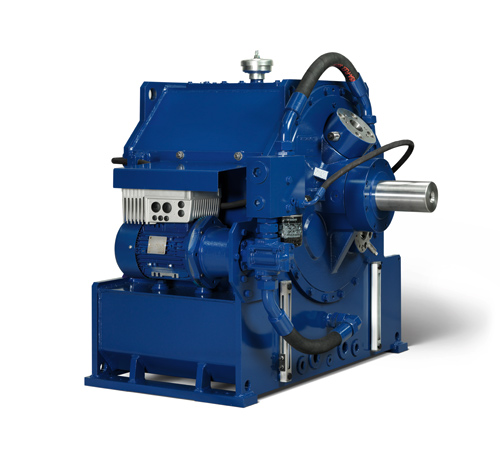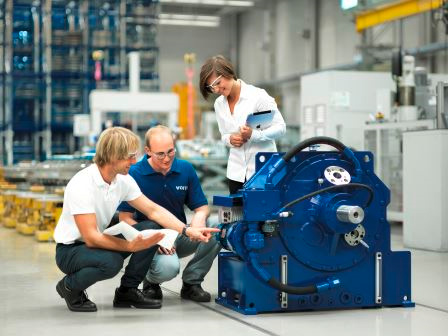
The TurboBelt 500 TPXL fluid coupling from Voith Turbo protects drive components from unexpected overloads.
When equipment like large mining conveyors must handle heavy and varying loads, users often turn to hydrodynamic couplings to protect drive components and systems. Expanding its product line, Voith Turbo, York, Pa., recently introduced its TurboBelt 500 TPXL fluid coupling at this year’s MINExpo in Las Vegas. The fill-controlled coupling is the first model in the new TPXL family, which reportedly combines the advantages of proven hydrodynamic-drive principles with advanced control technology.
As a bit of background, the couplings convert motor torque to fluid flow via an internal rotating pump wheel which, in turn, drives a turbine wheel that transmits mechanical energy to power a conveyor. Thanks to hydrodynamic operation, power transmission is wear-free and does not require a mechanical connection. In addition, the couplings are designed to “slip” when a conveyor is blocked or overloaded and effectively protect the driveline from damage. This minimizes maintenance and repair costs and increases the life of the system.
Fill-controlled couplings can continuously vary the fluid level in the circuit from completely full to empty. Changing the fill level in the working circuit smoothly and steplessly adjusts the transmitted torque and consequently, operating speed.
The TPXL’s electronic control system can adapt the coupling’s output torque exactly to conveyor start-up conditions and permits run-up times that can last several minutes. That reduces tensile forces during start-up of belt conveyors. Motors can power on and speed up under no-load conditions using the fill-control system. This minimizes current peaks that always occur when motors are switched on. It also reduces the load placed on the power grid.
In operation, users need only transmit the belt’s required torque and basic start-up parameters, and the control unit automatically calculates the optimum fill quantity and immediately fills or drains the working circuit accordingly. Equipped with a self-learning function, it simultaneously stores all relevant operational data to match control behavior with actual operations, based on the respective load and previous empirical values.
In addition, the controller, pump and new oil-supply unit are designed to work as a single subsystem that offers the capability for predictive, requirement-oriented maintenance of the coupling. The controller monitors temperature, pressure and speed sensors on the coupling and provides relevant diagnostic information, such as the condition of the oil filter. Remote access capabilities are available.
 Another significant enhancement is that Voith engineers have considerably increased the power density of the new coupling, due to a redesign of the vanes on the TPXL pump and turbine wheels. “It’s a bit of a breakthrough on the profiles of the drive and driven wheels,” said Kyle Kluttz, director of NBS Mining Americas for Voith Turbo. Compared with previous refinements, vane profiles on the new TPXL have been deepened, he explained, and this maximizes how much torque is transmitted between the wheels for a given size.
Another significant enhancement is that Voith engineers have considerably increased the power density of the new coupling, due to a redesign of the vanes on the TPXL pump and turbine wheels. “It’s a bit of a breakthrough on the profiles of the drive and driven wheels,” said Kyle Kluttz, director of NBS Mining Americas for Voith Turbo. Compared with previous refinements, vane profiles on the new TPXL have been deepened, he explained, and this maximizes how much torque is transmitted between the wheels for a given size.
That means the TurboBelt 500 TPXL only requires half the volume to transmit the same torque, doubling the power density compared to similar, conventional couplings. “As a result, it’s more compact and your overall footprint is smaller, so you can transmit more power at a lower cost,” said Kluttz.
In parallel with the controller, the TurboBelt 500 TPXL is also equipped with a fieldbus unit. According to Voith officials, that lays the foundation for future networked-mining applications. Networked components that encompass the entire extraction process will increase conveyor performance, productivity and worker safety, said the company.
The unit is rated for speeds of 1,200 to 1,800 rpm and a power range of 250 to 600 kW. As a self-contained system, the coupling permits quick and straightforward installation to avoid long production interruptions. Also, to facilitate integration into new and existing drivelines, Voith offers a version with bearings on both sides for standalone use, as well as with bearings on the output side for direct motor connection.
Voith Turbo
www.voith.com
Filed Under: News, Pumps & Motors